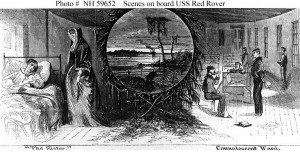According to historian and author J. David Davies, the concept of a hospital ship was well established in 17th century Britain. During the Anglo-Dutch wars most casualties were taken ashore in small boats, though several dedicated hospital ships including the Loyal Katherine, the Joseph, the Maryland Merchant, and the Helderenberg were commissioned during the second Anglo-Dutch war.
Yet during those “neighborhood wars” many injured sea men were cared for in private homes in seaport towns. In Davies’ book Pepys’s Navy; Ships, Men & Warfare 1649-1689, he describes private citizen Elizabeth Alkin, known as Parliament Joan, who nursed seamen at Portsmouth before 1653, when she moved to Harwich. She used her own resources for the men’s care, which included Dutch prisoners of war and was partly compensated by the government before she died in 1655.
During Queen Anne’s wars women served on hospital ships, says Christopher Lloyd in The British Seaman. Suzanne Stark has more to say on the subject in Female Tars; Women aboard ship in the Age of Sail. In 1696 each of England’s six existing hospital ships was to be assigned six nurses and four laundresses. They were paid able seamen’s wages. There were continual complaints that the women were drunk and disorderly, but there were also complaints of the male assistants being drunk and disorderly. According to Stark, hospital ships were usually worn-out sixth-rates or converted merchant vessels. There was usually only one surgeon aboard, about four suregeon’s mates, six nurses, and four laundresses.
In 1703 Admiral George Byng and Daniel Furzer, surveyor of the navy, recommended that the women nurses be replaced by men. The navy ruled that women would not be hired to serve in hospital ships, “except when circumstances required.” Such circumstances quickly developed that same year. (Incidentally, Admiral George Byng was not the Admiral John Byng who was court-marshaled and put to death in 1757 during the Seven Years War with France pour encourager les autres – or, failing to do his utmost to prevent Minorca from falling to the enemy.)
I’ve found a few mentions of American vessels serving as temporary hospital ships during the early nineteenth century, the most famous being the ketch, Intrepid. A few months after Stephen Decatur used the Intrepid to sneak into harbor to destroy the U.S. frigate Philadelphia which had been captured by the Tripolitans, the ketch served briefly as a hospital ship in the Mediterranean.
During the American Civil War the Sanitary Commission and the U.S. Army charterd steamers as makeshift floating hospitals on the Western Rivers. It wasn’t until December 26, 1862 that the United States Navy commissioned its first hospital ship. The Red Rover was a sidewheel steamship the Union Army captured from the Confederates. The Illinois Prize Board sold the Red Rover to the Navy The ship’s first patient as a commissioned hospital ship was a cholera victim. The medical staff included 30 surgeons and male nurses, and four female nurses; sisters of the Order of the Holy Cross. They were joined later by several other nuns and some black female nurses. When a naval hospital was built in Memphis, Tennessee, the Red Rover was relieved of some of her duties and she was removed from the service November 17, 1865.
